Airbus selects Blacktree Technology for UHF SATCOM services across Australasia
Airbus Defence and Space has selected Blacktree Technology Pty Ltd. of Perth, Australia, to provide the ground segment for the Airbus funded, UHF military communications hosted payload on-board a commercial telecommunications satellite manufactured by Airbus.

Blacktree Technology UHF satcom antenna systems atop
the Citadel in London
The payload with 18 UHF channels will enable up to 200 simultaneous communications over Europe, the Middle East, Africa, large parts of Asia, as well as the Atlantic Ocean (to eastern Brazil) and the Indian Ocean (to western Australia). The Airbus funded UHF payload will serve allied armed forces including European and NATO countries.
Airbus Chief Representative, Australia, New Zealand and the Pacific, Stephen Forshaw, said that the selection reinforced Airbus commitment to integrate Australian technology into the wider Airbus supply chain. “We’ve been excited to see how much technology is being developed by local companies to support the development of the Space industry in Australia, and that they are winning selection to provide global solutions in Space,” he said.
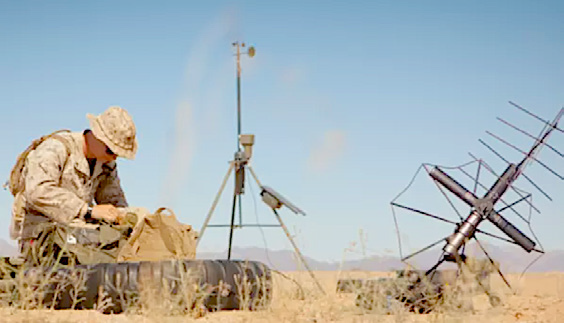
Airbus funded UHF payload will serve allied armed forces
including European and NATO countries
Martin Rowse, Airbus Defense and Space Australia director said, “We have selected Blacktree as they offer a proven Australian solution which will support this critical satellite communications capability. The ground segment will be essential in ensuring our customers have access to vital UHF connectivity across the region and beyond.”
Blacktree Technology’s Managing Director, Joe Nevin, added, “Blacktree Technology is proud to, once again, be selected to support Airbus with UHF ground segment capability. This builds on our strong heritage providing UHF solutions in Australia and across the globe.”
Airbus has been working with Blacktree for more than 15 years under the UK’s SKYNET 5 secure MILSATCOM program and is partnering with them in Team Maier as part of the bid to address Australia’s Joint Project (JP) 9102 to provide a complete Sovereign Defense Satellite Communications System. Team Maier members include technology and encryption specialists Blacktree Technology, Clearbox Systems, Penten, UGL, Surrey Satellite Technology and Willyama.
Benchmark Space Systems wins 2nd AFRL contract for new thrusters testing
Benchmark Space Systems has received a two-year, $2.81 million Air Force Research Laboratory (AFRL) SPRINT (Space Propulsion Research and Innovation for Neutralizing Satellite Threats) award to further develop and test flight- optimized thrusters running on ASCENT (Advanced Spacecraft Energetic Non-Toxic) fuel.
Benchmark Space Systems and AFRL are unleashing ASCENT as a viable, safer, green propellant for defense and government missions.
This is Benchmark’s second SPRINT award in two years, after the company successfully demo’d a prototype thruster burning the (AFRL) developed, Advanced Space Craft Energetic Non-Toxic (ASCENT) monopropellant without the use of a catalyst bed. The milestone trials opened the door to ASCENT as an affordable, viable alternative for a broad range of on-orbit mobility and tactical missions in space.

Benchmark’s collaborative work with AFRL and the U.S. Government is a model example of how the company thoroughly vets the safety and optimizes performance of propellant for use in space, such as the flight-proven high-test peroxide (HTP), bi- propellant running the company’s Halcyon product line.
Benchmark propellant innovations also include the inert non-toxic powder fueling its Starling systems, and a variety of readily and domestically sourced metals to feed its Electric Propulsion offerings.
Benchmark’s propellants team will continue to screen and solve inherent propellant challenges, including hurdles posed by LMP-103, nitrous oxide, water, and other fledgling propellants that have shown promise for specific mission types.
Benchmark’s expertise and stringent development and test regimen has led to a growing thruster and propellants lineup that is well positioned to power a wide range of government and commercial missions.
As part of this new AFRL-funded program, Benchmark is building a flight-like, 22 Newton thruster to perform advanced ASCENT, hot- fire demos and will also deliver a preliminary design of a larger, 100 Newton thruster assembly in 2025, with the goal of meeting overall demand for scaled, ASCENT- fueled, spacecraft in the 10-500 Newton range.
Benchmark also unveiled the company’s new Advanced Propellants Group, led by Director Michael Martin, Ph.D., who has spearheaded much of the ASCENT thruster prototype development and testing, both at Benchmark’s technology center in Pleasanton, California, and labs at Texas A&M University in College Station, Texas. The new team will build on Benchmark’s overall mission to explore and test a broad range of greener propellants for its growing suite of proven non-toxic chemical, electric and hybrid propulsion systems.
“Benchmark has developed a novel ASCENT thruster technology that provides the high- thrust scalability to make ASCENT a viable propellant across the full necessary performance range of DoD’s current and future dynamic space operations. This next two-and-a-half-years of ASCENT thruster prototype development and testing under the SPRINT program will ultimately enable the refinement and scale of storable monopropellant systems and operations to support immediate off-the-shelf availability for rapid deployment defense missions.”
— Jake Teufert, Benchmark Space Systems Chief Technology Officer
“Our expertise in non-toxic propulsion systems and testing means Benchmark is well positioned to provide thrust to a wide range of government and commercial spacecraft on low Earth orbit, lunar, and cislunar missions. We are non- toxic propulsion professionals who will open the door even wider for ASCENT usage, as we also explore bringing in other underutilized and promising green chemical, electric and hybrid technologies to power the space economy.” — Michael Martin, Ph.D. and Director of Benchmark’s Advanced Propellants Group
Boeing’s new military satellite
Boeing [NYSE: BA] recently unveiled the company’s Protected Wideband Satellite (PWS) design that features Boeing’s Protected Tactical SATCOM Prototype (PTS-P) payload hosted aboard the U.S. Space Force’s Wideband Global SATCOM (WGS)-11 spacecraft.
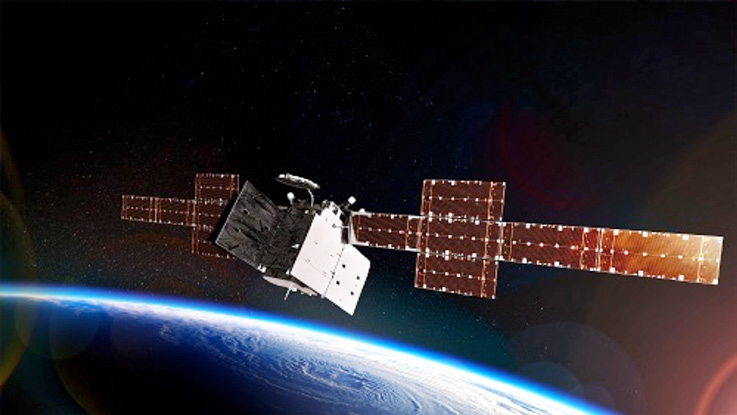
The combination of military satellite communications (MILSATCOM) and anti-jam capabilities underpin the PWS design.Both programs are based on Boeing’s 702X, software- driven technology enabling real-time and automated beam-forming for improved stand-off performance and signal protection.
The program is scheduled for launch in 2024, with on-orbit testing slated for 2025. After the on-orbit demo, the PTS-P payload will be available to transition for operational use.
The PTS-P design features automated anti-jam capabilities, including jammer geolocation, real- time adaptive nulling, frequency hopping and other techniques, harnessing the power of the U.S. military’s Protected Tactical Waveform (PTW) to ensure the warfighter can stay connected in a contested environment.
By flying PTS-P on the WGS- 11 spacecraft as part of the WGS constellation, PWS works seamlessly with all the existing WGS user terminals, while allowing gradual fielding of PTW modems in a theater of operation.
WGS provides the Department of Defense with a broad majority of tactical communications going through the constellation that currently includes 10 satellites.
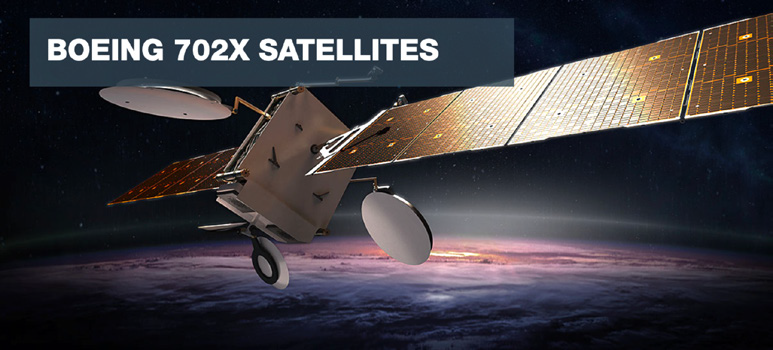
“The joint force is relying on usto deploy capabilities that enable secure communications in a prolific jamming environment.
We also need mission-relevant speed and affordability, while being mindful of the evolving threat in the battlefield. The Boeing PTS-Prototype payload hosted on WGS-11 is an exciting leap forward for new warfighter capabilities.” — Charlotte Gerhart, Space Systems Command’s Tactical SATCOM division chief at the U.S. Space Force
“The Protected Wideband Satellite combines significantly upgraded WGS capability with PTS-P’s automated anti-jam features. This capability sets the stage for future generations of protected wideband systems that can operate in both legacy transponded and new onboard processed modes.” — Michelle Parker, Vice President of Boeing’s Space Mission Systems
Rocket Lab to launch four Leidos HASTE missions
Rocket Lab USA, Inc. (Nasdaq: RKLB) has signed a contract with Leidos to launch four HASTE (Hypersonic Accelerator Suborbital Test Electron) missions.
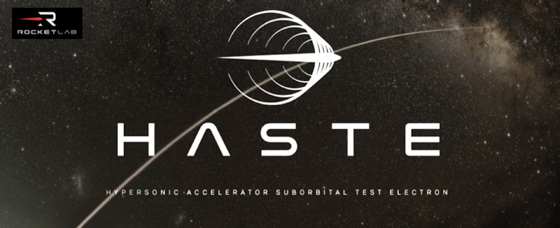
The missions, scheduled across 2024 and 2025, will lift off from Rocket Lab Launch Complex 2 at Virginia’s Mid-Atlantic Regional
Spaceport within NASA’s Wallops Flight Facility.
Rocket Lab was selected by Leidos to provide hypersonic test launch capabilities with HASTE under the MACH-TB project.
The project was awarded by Naval Surface Warfare Center (NSWC) Crane through the Strategic and Spectrum Missions Advanced Resilient Trusted Systems (S2MARTS) Other Transaction Authority (OTA) vehicle on behalf of the U.S. Department of Defense (DoD) Test Resource Management Center (TRMC).

Rocket Lab Launch Complex 2 within the Mid-Atlantic Regional Spaceport at NASA Wallops Flight Facility in Virginia is the launch site for HASTE.
Tailored specifically for technology demonstration missions, HASTE launches from Wallops carry on the extensive tradition of suborbital launch from Virginia’s coast and stands ready to serve the current and future technology needs of hypersonic and suborbital test missions.
Rocket Lab’s HASTE suborbital launch vehicle is derived from the company’s Electron rocket but has been modified to support hypersonic payload deployment.
By leveraging the heritage of Rocket Lab’s low-cost Electron, HASTE offers true commercial testing capability at a fraction of the cost of current full-scale tests.
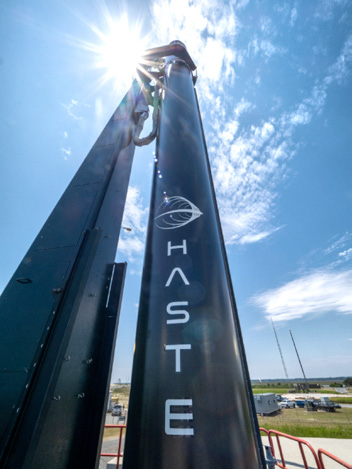
Rocket Lab launched the first HASTE mission on June 17, 2023, for Leidos under the Multi-Service Advanced Capability Hypersonic Test Bed (MACH-TB) program.
HASTE is operated under Rocket Lab National Security (RLNS), the Company’s wholly owned subsidiary created to serve the unique needs of the U.S. defense and intelligence community and its allies.
“Our first HASTE mission in June this year successfully demonstrated HASTE’s ability to accelerate the cadence of hypersonic flight testing for the nation. We’re proud to now follow it up with a series of four additional missions for Leidos to support hypersonic technology innovation and technology maturation.” — Brian Rogers, Senior Director, Global Launch Services
NGA, NRO, USSPACECOM plan for threats to commercial satellites
The National Geospatial-Intelligence Agency (NGA), the National Reconnaissance Office (NRO) and U.S. Space Command (SSC) recently signed a first-of-its-kind agreement outlining a framework to enable the protection of commercial remote sensing space assets vital to the nation’s intelligence collection mission.
The Commercial Space Protection Tri-Seal Strategic Framework (Executive Summary) finds the three organizations jointly engaging in threat information and conduct as well asother measures to avoid or reduce harm to commercial satellites from potential threats.

This is the first comprehensive agreement between the intelligence community and USSPACECOM on how to bring commercial vendors into the information-sharing process to help ensure effective joint collaboration and cooperation from the minute an event happens, with near real- time information sharing about any risks and threats to NRO-contracted commercial space capabilities.
The global commercial satellite industry continues to grow exponentially, with the launch of hundreds of
commercially-built satellites into orbit in the last few years and thousands more planned in the near future.
Similarly, the U.S. intelligence and defense communities increasingly rely on commercial satellites to add resiliency to U.S. capabilities and provide commercial imagery and other services to complement and extend the reach of government- owned space assets.
The unclassified, shareable nature of commercial imagery makes it an especially valuable source for information sharing with U.S. partners and allies.
For example, it has played a significant role in the Russia-Ukraine conflict. NGA and NRO have applied tailored tasking and acquisition strategies to maximize collection over the region, working with partners and commercial suppliers to expand user access and enable the rapid dissemination of commercial imagery.
Of course, the growing impact of those commercial resources has also increased adversaries’ attention on them. As commercial providers expand their space-based capabilities, their assets face higher risk of targeted interference.
The new framework begins to address those concerns and helps ensure NRO-contracted commercial imagery providers are aware of — and can plan for — threats within a more congested and contested space environment. It also facilitates communication about potential threats between the government entities and commercial providers.
Overall, the framework defines the roles and responsibilities of NGA, NRO and USSPACECOM in three critical areas — threat information sharing, anomaly investigation and response and collection strategies:
• Threat information sharing between the U.S. government and the commercial sector creates a better understanding of the space domain in general and the threats to collection assets specifically
• Anomaly reporting, investigation and response are needed to inform appropriate and timely actions in the face of current and emerging threats
• Commercial imagery collection strategies may need to be adjusted if threats require a change to commercial collection postures
U.S. Space Command will lead threat information sharing with NRO-contracted commercial imagery providers and the NRO Operations Center for space events, counterspace attack and USSPACECOM warning problems.
The command will also lead investigations into anomalies reported by commercial imagery providers, in coordination with NGA, NRO and other organizations as appropriate.
By delineating roles and responsibilities in these areas, NGA, NRO and USSPACECOM ensure their organizations effectively identify, assess and adapt to threats against commercial imagery collection.
This framework also helps ensure NRO-contracted commercial imagery providers are properly informed of emergent and imminent threats to their space assets, enabling providers to make informed decisions to best support collection operations and benefit them in their support of U.S. government and non- governmental customers.
Over the next six months, NGA, NRO and USSPACECOM will jointly complete concepts of operations and standard operating procedures for implementing the framework and improving commercial satellite protection going forward.
“This agreement is additional recognition of how valuable commercial image providers have become in the space environment. Our commercial vendors give us the flexibility to strategically consider all available capabilities — whether government or commercial — to make certaibn we can get the right data to the right place at the right time.” — Frank Avila, Acting Director, Commercial Operations, NGA
“Space is an extremely contested environment, and it’s only getting more so. That’s true not only for government systems operating in space, but for our commercial systems as well.”
— Pete Muend, Director of Commercial Systems Program Office, NRO
“This cornerstone agreement advances U.S. Space Command’s space domain awareness through additional, non-traditional sources of information. The lessons learned from implementing this historic framework will enhance the U.S. government’s ability to bi-laterally share time-sensitive threat information with commercial providers..” — Victor Vigliotti, Chief of Commercial Integration Branch, U.S. Space Command
SAS supports MAG Aerospace on million$$$ USSF contract
SAS and MAG Aerospace are teaming to pursue opportunities from the recently awarded U.S. Space Force Space Systems Command (SSC) $900 million indefinite delivery, indefinite quantity (IDIQ) contract.

SAS and MAG Aerospace will bring expertise in AI, analytics and Joint All-Domain Command and Control to the space realm, enabling the U.S. Space Force (USSF) to analyze and use all the data being delivered by the organization’s vast network of radars and sensors.
The Space Systems Command IDIQ contract is in support of Space Command and Control (C2). Space Force tracking radars and other sensors produce incredible amounts of data from thousands of locations. Last year, the Space Command tracked more than 47,000 objects in space.
There is a critical need to convert this proliferation of diverse sensor data accurately and rapidly into usable, real-time intelligence for mission success.
SAS’ deep analytical capabilities enable commanders to enhance and accelerate decision making while promoting full network and data integration.

MAG Aerospace has successfully hosted the SAS® Viya® platform in a secure cloud environment for
processing Internet of Things (IoT) data and performing advanced analytics at the tactical edge. SAS Viya — an open, cloud-native AI, analytics and data management platform — supports MAG’s Intelligence, Surveillance and Reconnaissance (ISR) requirements across the full analytics life cycle, from the edge to analysis of data sets in complex operational environments.
Powered by Viya, SAS Analytics for IoT places the power of insight into users’ hands to provide value that is realized from fast-moving, voluminous data in hours and days, not months.
SAS’ legacy in aerospace traces back to the Space Race, when Jim Goodnight, Co-Founder and CEO of SAS, worked as a programmer on the Apollo Project. He later co- developed the SAS programming language and co-founded SAS, building a software industry leader that has been providing AI and analytics solutions to the federal government for nearly 50 years.
“For nearly 50 years, SAS has been an industry leader in applying AI and analytics to the most complex mission challenges. As Space Force embarks on its burgeoning mission to conduct global space operations, we believe our alliance with MAG Aerospace is uniquely positioned to deliver on Space Systems Command’s IDIQ task order opportunities by enabling data and network interoperability across all operating environments.” — Caroline Baldwin, Director, SAS Federal
Secure World Foundation issues ASAT testing + more...
Secure World Foundation (SWF) has released updated versions of 11 fact sheets related to counterspace capabilities that cover ASAT testing in space, RPOs conducted in Earth orbit, and the X-37B Orbital Test Vehicle.
Together, these activities have generated concerns from many countries about the increasingly contested nature of space. The SWF fact sheets provide updated factual information on the current status of these capabilities and assessments of their impact on space security and sustainability.
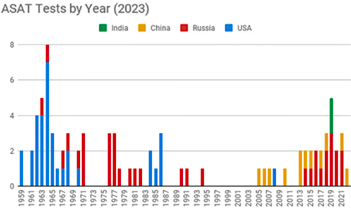
The continued proliferation counterspace capabilities and resurgence of anti-satellite (ASAT) testing in space and growth in robotic rendezvous and proximity operations (RPOs) conducted for military and intelligence purposes have generated concerns from many countries about the increasingly contested nature of space.
While many RPO activities are not directly aggressive or destructive themselves, they can lead to misconceptions or heightened tensions that could negatively impact space security and stability.
Additionally, destructive ASAT tests have created thousands of pieces of orbital debris over the last several decades, which can pose long-term risks to all space activities.
Each fact sheet summarizes the history of that country’s programs in those areas, provides a table listing known tests of those programs in space (including any intercepts and orbital debris created), and a short analysis of the current state of development or operational status.
Additional details and links to the SWF fact sheets are at this direct link...For more information, please contact Dr. Brian Weeden or Ms. Victoria Samson.



